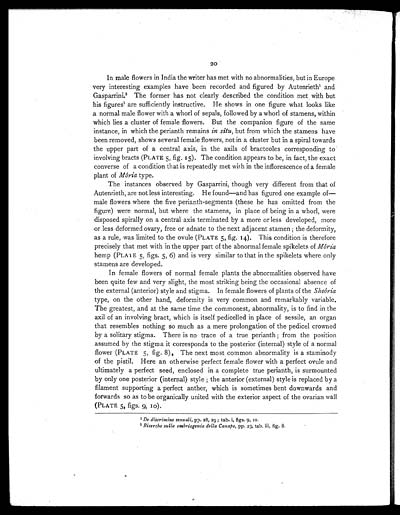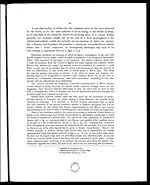Medicine - Institutions > Army health reports and medical documents > Scientific memoirs by officers of the Medical and Sanitary Departments of the Government of India > Number 12 - On the morphology, teratology, and diclinism of the flowers of cannabis > On the morphology, teratology, and diclinism of the flowers of cannabis
(26) Page 20
Download files
Individual page:
Thumbnail gallery: Grid view | List view

20
In male flowers in India the writer has met with no abnormalities, but in Europe
very interesting examples have been recorded and figured by Autenrieth1 and
Gasparrini.2 The former has not clearly described the condition met with but
his figures1 are sufficiently instructive. He shows in one figure what looks like
a normal male flower with a whorl of sepals, followed by a whorl of stamens, within
which lies a cluster of female flowers. But the companion figure of the same
instance, in which the perianth remains in situ, but from which the stamens have
been removed, shows several female flowers, not in a cluster but in a spiral towards
the upper part of a central axis, in the axils of bracteoles corresponding to
involving bracts (PLATE 5, fig. 15). The condition appears to be, in fact, the exact
converse of a condition that is repeatedly met with in the inflorescence of a female
plant of Mória type.
The instances observed by Gasparrini, though very different from that of
Autenrieth, are not less interesting. He found—and has figured one example of—
male flowers where the five perianth-segments (these he has omitted from the
figure) were normal, but where the stamens, in place of being in a whorl, were
disposed spirally on a central axis terminated by a more or less developed, more
or less deformed ovary, free or adnate to the next adjacent stamen; the deformity,
as a rule, was limited to the ovule (PLATE 5, fig. 14). This condition is therefore
precisely that met with in the upper part of the abnormal female spikelets of Mória
hemp (PLATE 5, figs. 5, 6) and is very similar to that in the spikelets where only
stamens are developed.
In female flowers of normal female plants the abnormalities observed have
been quite few and very slight, the most striking being the occasional absence of
the external (anterior) style and stigma. In female flowers of plants of the Sheória
type, on the other hand, deformity is very common and remarkably variable.
The greatest, and at the same time the commonest, abnormality, is to find in the
axil of an involving bract, which is itself pedicelled in place of sessile, an organ
that resembles nothing so much as a mere prolongation of the pedicel crowned
by a solitary stigma. There is no trace of a true perianth; from the position
assumed by the stigma it corresponds to the posterior (internal) style of a normal
flower (PLATE 5, fig. 8), The next most common abnormality is a staminody
of the pistil. Here an otherwise perfect female flower with a perfect ovule and
ultimately a perfect seed, enclosed in a complete true perianth, is surmounted
by only one posterior (internal) style; the anterior (external) style is replaced by a
filament supporting a perfect anther, which is sometimes bent downwards and
forwards so as to be organically united with the exterior aspect of the ovarian wall
(PLATE 5, figs. 9, 10).
1 De discrimine sexuali, pp. 28, 29; tab. i, figs. 9, 10.
2 Ricerche sulla embriogenia della Canape, pp. 23, tab. iii, fig. 8.
Set display mode to: Large image | Zoom image | Transcription
Images and transcriptions on this page, including medium image downloads, may be used under the Creative Commons Attribution 4.0 International Licence unless otherwise stated. ![]()
| Permanent URL | https://digital.nls.uk/75026794 |
|---|
| Shelfmark | IP/QB.10 |
|---|---|
| Additional NLS resources: | |




